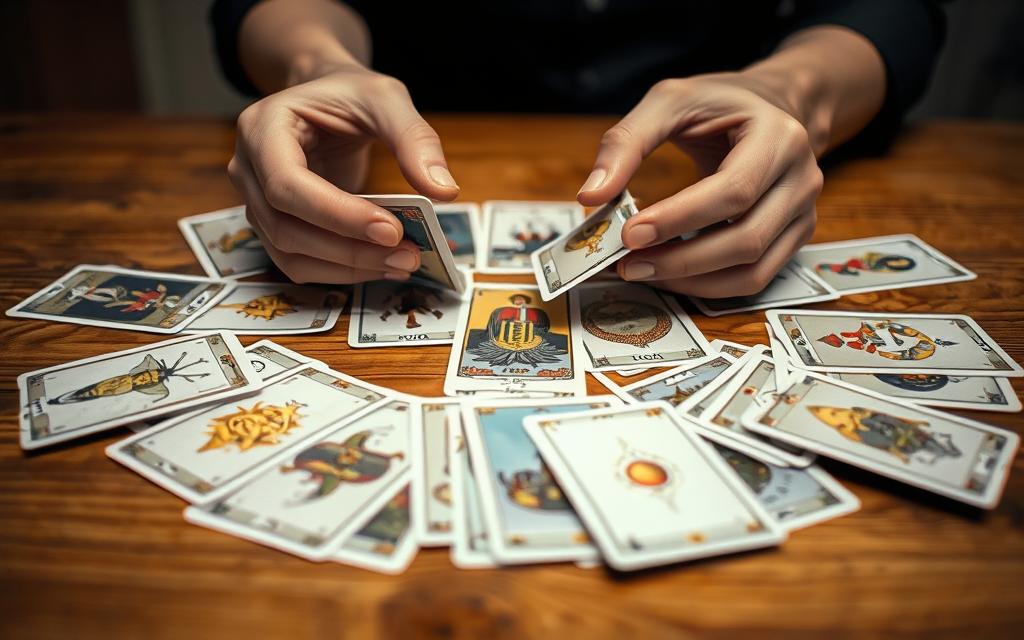Shuffling a tarot deck is more than just mixing cards; it’s about connecting with the deck’s energy and preparing for a meaningful reading. Proper tarot deck shuffling techniques can enhance your connection to the cards and ensure a more accurate and insightful reading.
Various methods exist for shuffling a tarot deck, each with its unique benefits. From the basic Overhand Shuffle to more complex techniques like the Celtic Cross Shuffle, understanding these methods can elevate your tarot practice. For a deeper dive into these techniques, you can explore resources like tarot shuffling guides, which provide detailed instructions and insights into the art of shuffling.
Mastering the art of shuffling can transform your tarot readings, making them more intuitive and connected to the querent’s energy. By learning and practicing different shuffling techniques, you can enhance your tarot practice and provide more meaningful readings.
Table of Contents
Understanding Your Tarot Deck Before Shuffling
Before you start shuffling your tarot deck, it’s essential to understand the intricacies of the deck itself. A tarot deck is a complex tool used for divination and self-reflection, comprising 78 cards with various symbolism and meanings.
Types of Tarot Decks and Their Characteristics
There are numerous types of tarot decks, each with its unique characteristics and artwork. The most popular is the Rider-Waite tarot deck, known for its detailed illustrations and symbolism. Other decks, such as the Thoth tarot deck, offer different interpretations and imagery. Understanding the specific deck you’re using is crucial for accurate readings.
| Tarot Deck Type | Characteristics |
|---|---|
| Rider-Waite | Detailed illustrations, rich symbolism |
| Thoth | Complex symbolism, esoteric themes |
| Marseille | Traditional French symbolism, simple imagery |
Preparing Your Deck for Shuffling
Preparing your tarot deck for shuffling involves more than just mixing the cards. It’s about creating a connection between you and the deck. Start by holding the deck in your hands and focusing your energy on the cards. This simple act can help attune you to the deck’s energy.
“The tarot deck is a tool, and like any tool, it needs to be handled with care and respect.”
Cleansing and Connecting with Your Cards
Cleansing your tarot deck is an essential step before shuffling. This can be done by placing the deck in a sacred space, using a cleansing crystal, or simply by setting an intention to clear the deck’s energy. Connecting with your cards involves understanding their symbolism and meanings, allowing you to tap into their deeper significance during readings.
By understanding your tarot deck, preparing it for shuffling, and cleansing the cards, you create a strong foundation for meaningful and accurate tarot readings.
Basic Techniques on How to Shuffle a Tarot Deck
The foundation of a successful tarot reading lies in the shuffling process, where several basic techniques come into play. Shuffling is not just about randomizing the order of the cards; it’s also about connecting with the deck and preparing it for the reading.
The Overhand Shuffle Method
The overhand shuffle is a simple and intuitive method that many beginners start with. To perform an overhand shuffle, hold the deck in one hand and use the other hand to shuffle the cards by releasing a few cards at a time from the top of the deck and letting them fall into your waiting hand. This process is repeated several times until the cards feel sufficiently mixed.
Tips for the Overhand Shuffle: Keep your movements smooth and controlled. The overhand shuffle is a great method for those who are new to tarot or prefer a more gentle approach to shuffling.
The Riffle Shuffle Technique
The riffle shuffle is a more advanced technique that involves dividing the deck into two halves and then riffing them together. To do this, split the deck into two equal parts and hold each half in one hand. Use your thumbs to release the cards from both halves, allowing them to interleave as they fall. This method requires a bit of practice to master but is very effective.
The Cut Method for Beginners
The cut method is another straightforward technique that involves dividing the deck into two or more parts and then recombining them. To cut the deck, simply lift a portion of the cards from the top and place them on the bottom, or vice versa. This method is easy to learn and can be used in conjunction with other shuffling techniques.
| Shuffling Technique | Difficulty Level | Effectiveness |
|---|---|---|
| Overhand Shuffle | Easy | Moderate |
| Riffle Shuffle | Moderate to Hard | High |
| Cut Method | Easy | Low to Moderate |
Each of these basic techniques has its own advantages and can be used alone or in combination to achieve a thorough shuffle. Experimenting with different methods can help you find what works best for you and your tarot practice.
Advanced Shuffling Methods for Tarot Cards
Beyond the basics, tarot enthusiasts can explore sophisticated shuffling techniques to refine their practice. Advanced shuffling methods not only enhance the randomness of the cards but also deepen the connection between the reader and the tarot deck.
The Spreading Technique
The spreading technique involves laying out the cards on a flat surface and mixing them thoroughly. This method allows for a visual and tactile experience, enabling the reader to connect with the cards on a deeper level. By spreading the cards, one can also observe the overall energy and patterns within the deck.
The Hindu Shuffle Method
The Hindu shuffle, also known as the “table cut,” is a simple yet effective method. It involves holding the deck in one hand and using the other hand to pull out a portion of the cards, then releasing them back into the deck. This technique is particularly useful for those who prefer a more controlled shuffle. The Hindu shuffle is a great way to maintain the integrity of the deck while still achieving a good mix.
Combining Different Shuffling Techniques
For a more dynamic reading experience, combining different shuffling techniques can be highly beneficial. By mixing methods such as the overhand shuffle, riffle shuffle, and Hindu shuffle, readers can achieve a high level of randomness and keep their practice fresh. Experimenting with various techniques also allows readers to discover what works best for them and their unique connection to the tarot cards.
Ultimately, the key to advanced tarot shuffling is to find a method that resonates with you and enhances your reading experience. Whether you prefer a single technique or a combination, the goal is to create a meaningful and insightful reading.
Setting Intention While Shuffling Your Tarot Cards
The act of shuffling tarot cards can be a powerful ritual when done with intention and focus. By setting a clear intention, you infuse your reading with purpose and clarity, allowing for a more meaningful and accurate interpretation.
Focusing Your Energy
Focusing your energy during shuffling is crucial for an effective tarot reading. To achieve this, start by centering yourself through a brief moment of meditation or deep breathing. This helps to clear your mind and direct your energy towards the task at hand. As you shuffle, maintain a steady and deliberate pace, avoiding distractions that might dilute your focus.
Incorporating Breathing Techniques
Incorporating breathing techniques into your shuffling process can enhance your connection with the tarot cards. Try synchronizing your breath with your shuffling motion, creating a harmonious flow that calms the mind and aligns your energy. For example, you can inhale as you split the deck and exhale as you recombine it, fostering a sense of balance and continuity.
Visualizing Your Question or Intention
Visualizing your question or intention is a powerful way to imbue your tarot reading with clarity and purpose. As you shuffle, hold your question or intention clearly in your mind, visualizing the outcome or insight you seek. This focused visualization helps to attune the cards to your query, providing a more relevant and insightful reading. For more on creating effective tarot spreads, you can learn how to create your own tarot, tailoring it to your specific needs and questions.
By combining these techniques—focusing your energy, incorporating breathing techniques, and visualizing your question or intention—you can transform the simple act of shuffling tarot cards into a profound and meaningful ritual that enhances your tarot reading experience.
When and How Often to Shuffle During Readings
Effective tarot card shuffling during readings involves more than just randomizing the order of the cards. It’s about understanding the context and the type of reading being performed.
Shuffling is a crucial step that can significantly impact the outcome of a tarot reading. The frequency and method of shuffling can vary based on the type of spread being used.
Shuffling for Different Types of Spreads
Different tarot spreads require different shuffling approaches. For instance, a simple three-card spread may require a quick and straightforward shuffle, while a more complex spread like the Celtic Cross may benefit from a more thorough shuffling process.
Understanding the specific needs of each spread is key to effective shuffling. This ensures that the cards are properly randomized and that the reading is accurate.
Dealing with Reversed Cards While Shuffling
Reversed tarot cards can add a layer of complexity to a reading. When shuffling, it’s essential to decide whether to include reversed cards or to keep the deck upright.
The decision to include reversed cards depends on the reader’s preference and the context of the reading. Some readers prefer to keep the deck upright to avoid reversals, while others see reversals as an integral part of the reading.
Recognizing Jumped or Fallen Cards
Jumped or fallen cards during shuffling can hold significant meaning. These cards can be seen as indicators of key themes or messages that the querent needs to address.
Recognizing and interpreting these cards requires a combination of intuition and understanding of the tarot deck. It’s a skill that develops over time with practice and experience.
Conclusion
Mastering the art of tarot deck shuffling is a crucial step in becoming a proficient tarot reader. By understanding the various techniques and incorporating them into your practice, you can enhance the accuracy and depth of your readings. The methods discussed, from basic to advanced, provide a comprehensive foundation for exploring different tarot spreads and connecting with the cards on a deeper level.
As you continue to practice and refine your tarot shuffling skills, you’ll find that your confidence and proficiency grow. This, in turn, allows you to provide more insightful and meaningful readings for yourself and others. The key to tarot shuffling conclusion lies in consistent practice and a willingness to explore the various techniques available.
By incorporating the principles outlined in this guide, you’ll be well on your way to mastering tarot deck shuffling and unlocking the full potential of your tarot practice.


